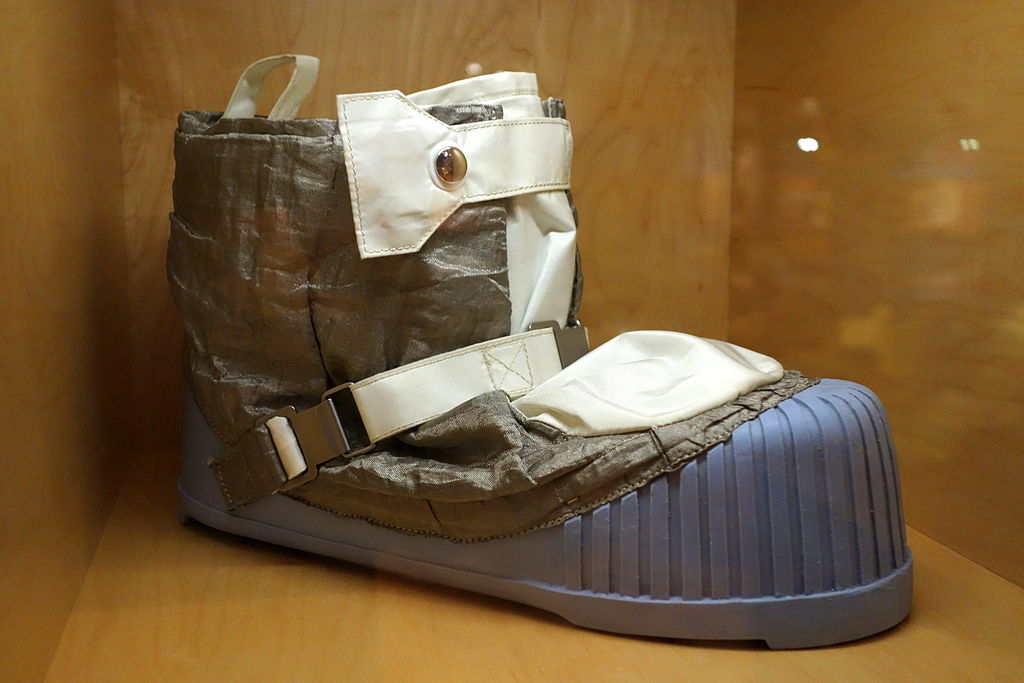Moonwalking made easy
UND, Cankdeska Cikana Community College on the Spirit Lake Reservation partner to design lunar boot outsole for NASA

Editor’s note: In the UND LEADS Strategic Plan, the Discovery core value calls on the University to “facilitate and enhance connections, where new and existing partners — including industry, government and inter-institutional collaborations, among others — can easily engage, and where internal efforts to foster partnerships can be supported and flourish.” The story below, which UND Today first printed on Dec. 7, spotlights one of the University’s latest efforts to partner with tribal colleges, in accordance with the Plan.
****
The first pair of boots to touch the moon’s surface were designed by GE for the Apollo 11 mission. Made from silicon rubber, they were rugged and made to withstand extreme conditions.
While their functional design has evolved over time, there is still room for improvement. UND’s Jesse Rhoades; Advanced Manufacturing Instructor Nick Bittner of Cankdeska Cikana Community College, a tribal community college in Ft. Totten, N.D., on the Spirit Lake Reservation; and some of Bittner’s students have a few ideas to make that happen.
UND and Cankdeska Cikana have partnered on a NASA grant to develop lunar boot outsoles. The grant, which will provide just under $1 million in funding over three years, is a part of NASA’s Artemis program.
As part of the grant, UND’s BiPed lab is testing models created by Cankdeska Cikana’s manufacturing course students. Their goal is to design, build and test detachable outsoles that correct some of the problematic elements of lunar boots.
An out-of-this-world problem: Regolith
One of the major challenges is the tracking of lunar regolith, the powdery dust that covers the moon’s surface and is sharp, hazardous and potentially radioactive.
“We’re doing a huge amount of regolith testing on the outsoles,” said Jesse Rhoades, associate professor of kinesiology and director of the BiPed lab. “It has a really small particle size, so we’re testing things like how far the outsoles sink into the regolith and how the regolith flows through the device.”
Regolith attracts itself, said Bittner, and the sharp particles can make their way into electronics and sealed bearings in machinery if it gets into a space shuttle. They’re designing the outsole to be removable to avoid these hazards.
“NASA itself has spent tens of millions of dollars on dust mitigation,” Bittner said. “The original Apollo missions almost didn’t make it home because they didn’t realize how much of a danger regolith was. It’s really an engineering challenge and one of the most difficult materials I’ve ever worked with.”

Camels and elephants and pigs, oh my
The outsoles are also designed to help the wearer walk with a more natural gait. Lunar boots were designed to retain heat in extreme cold, making the soles flat, rigid and uncomfortable.
Before drafting their designs, Cankdeska Cikana students looked at animals whose hooves, claws and paws have adapted to walking on material like regolith. Sandpiper birds, whose long toes and webbed feet help them maintain stability walking in mud and sand, and other animals were reference points in the design process, Bittner said.
“This particular design is actually mainly taken from ungulates, four legged animals,” he said, referencing the model they were currently testing. “This outsole is a combination between the ergonomics of camels, the impact ability of elephants and the force distribution of pigs.”
The model, lovingly referred to by Bittner’s students as Mark II, has a unique shape. A scoop at the heel features springy, intertwined prongs that facilitate balance and energy retention as the heel and toe touch the ground.
Specifically, the outsoles mimic the contact and rebound of metatarsophalangeal (MTP) joints located at the knuckles of the toes. It allows for more energy retention when the toe and heel of the boot come into contact with the ground, allowing walking to feel more natural, like wearing a pair of tennis shoes.
Cankdeska Cikana students use a 3D printer to materialize their designs using Nylon 12, a resilient material that can withstand significant stress. Then, they send their models to UND’s BiPed lab to test their effectiveness.
“We use a large treadmill and an offload system to mimic lunar gravity, which is about a sixth of the Earth’s. We track this with motion capture to see how the design is normalizing gait,” Rhoades said. “They’ll take all of that feedback, redesign it and send it back to us. It goes back and forth.”
Bittner says that the collaboration offers a unique experience for the students at Cankdeska Cikana, who may participate in NASA internships and form relationships with UND researchers over the next three years.
“We’re leveraging the relationship between a research school like UND and Cankdeska Cikana, which has a legacy in advanced manufacturing,” Bittner said. “That means that we have the ability to fabricate the theoretical devices that researchers come up with and dynamically test them in the real world.”
One giant leap for STEM-curious students
This ties into the overarching goal of the goal, Rhoades said.
“What this grant is really about is trying to get students involved in STEM activities.”
“It gets students into contact with people such as Pablo De Leon, department chair of Space Studies,” Rhoades added. “It’s a really great opportunity for students at a minority-serving institution to see that they have the potential to work with people at UND and get NASA internships.”
And in that respect, the collaboration has already been a success.
Bittner said they received so much interest from students that they had to create multiple teams. Eventually, they will showcase their designs to systems material experts from NASA’s human spaceflight laboratories.
“We actually have one student who’s an internship candidate at the NASA research labs that are dedicated to certifying equipment, and that’s rare,” Bittner said. “We’re proving that younger students can perform if they’re given the opportunity.”
“The goal of the project, besides making something great, has been to bridge these two worlds and give opportunities to everyone,” Bittner added. “When you’re working on team and doing something like this, it creates really strong bonds. We’re hoping that it helps them build up a network of friends and mentors if they decide to attend UND.”
****
>> QUESTIONS OR COMMENTS about the UND LEADS Strategic Plan? Your thoughts are welcome! Please contact Angie Carpenter, UND’s director of Special Student Populations, and/or Ryan Zerr, associate vice president for Strategy & Implementation, the co-chairs of the UND LEADS Implementation Committee.
You also may offer your thoughts by visiting the UND LEADS Strategic Plan home page and clicking on the “Provide your feedback” link that you’ll find there.
Thank you for your support of the UND LEADS Strategic Plan!



